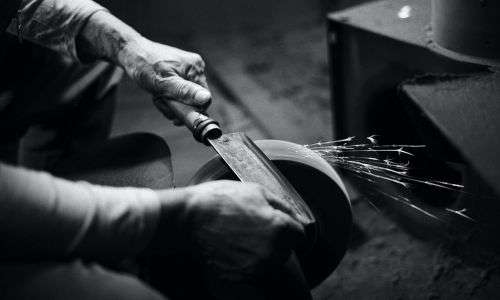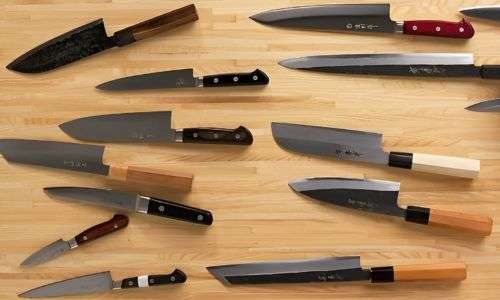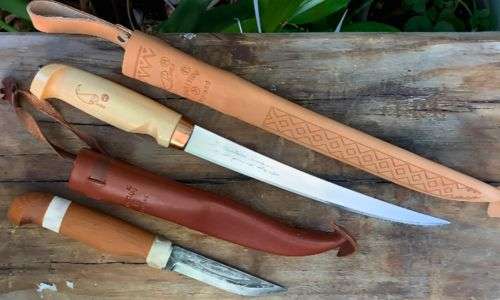Since the beginning of time, different locales have created particular styles of custom fillet knife cuts, each with its own attributes and reasons. We will examine four prominent styles in this essay: Damascus steel, Western, Japanese, and Scandinavian fillet knives. We hope to provide a comprehensive comparison of these remarkable culinary tools by examining their distinctive characteristics, materials, and intended applications. By understanding the essence of these styles, we aim to showcase the excellence of our custom fillet knives you can get.

Fillet knives often referred to as filleting blades, are essential tools in the culinary industry for delicate tasks like filleting fish. These specialized knives feature a trailing point blade that aids in filleting and provides excellent control. They are a versatile addition to the boning knife family, specifically designed for filleting and preparing fish. With blade lengths typically ranging from 15 to 28 cm (6 to 11 in), our custom fillet knives offer a unique scaling size that allows them to effortlessly glide along the backbone and under the skin of the meat.
Our Stainless Steel Made Custom Fillet Knife
The custom fillet knife blades we craft are made from various materials, with stainless steel being a popular choice among manufacturers. Stainless steel offers exceptional corrosion resistance, making it an ideal option for fillet knives that often come into contact with moisture during use.

Each knives are handcrafted with precision and care to enhance your culinary experience. Culinary professionals and home cooks have appreciated our knives because of their perfect combination of quality, performance, and creativity. As we constantly say, a satisfactory fillet knife is a key component to culinary perfection.
Balancing Flexibility and Precision
Our blades are intentionally designed to be thin, typically measuring around 2.5–3.5 mm at the spine. This thinness gives the blades the desired flexibility and bending ability while retaining a sharp edge. If the blades were thicker and too rigid, they would lack the flexibility to effectively remove the skin from a fillet or maneuver around intricate rib bones.
Enhanced Grip and Moisture Resistance
Fillet knives are frequently used in wet conditions; their handles must be ergonomically shaped to provide optimal grip. Additionally, the materials used for the handles must be resistant to the effects of moisture. While traditional custom fillet knives often featured wooden handles, modern advancements have introduced alternative materials such as rubber and plastics.
Unlike wood, which can absorb water and potentially become slippery, our bladesmiths produce tailormade knives with rubber and plastics to provide a reliable and secure grip even when the knife is wet. It enhances user control and minimizes the risk of accidents or mishandling while filleting.
Fillet Knives For Sale

Our Handcrafted Collection of Fillet Knives
At our workshop, we specialize in crafting a wide range of fillet knives. To make the ordering process convenient, we’ve integrated a WhatsApp chat button. Simply send us a message with your desired specifications, and we’ll be more than happy to assist you in acquiring the perfect customize fillet knife. Additionally, if you have specific requirements or preferences for a blade, we’re well-equipped to bring your vision to life.
You will have custom options such as grip colors materials finish ext as well as receive in real-time progress updates photos and videos as your custom blade is made tailored to you. This is a great way to purchase custom blades that is of my design
1. Damascus Fillet Knife
Damascus filet knives stand apart with their outwardly dazzling and remarkable examples, a consequence of the multifaceted manufacturing process that includes various layers of various sorts of steel. These knives have the ability to adopt a variety of blade designs, including Western and Japanese designs. Damascus steel fillet knives offer exceptional sharpness, edge retention, and overall performance in addition to their aesthetic appeal. Collectors and enthusiasts prize these knives because of their fine craftsmanship and artistic merit.

2. Japanese Fillet Knife
The Japanese-style filet knife, famous for its accuracy and nimbleness, is a wonder of craftsmanship. With its slight, slender cutting edge and sharp point, it succeeds in making sensitive and exact cuts. These blades frequently highlight a solitary slope edge, honed on one side only, taking into consideration particularly sharp and exact cutting. Typically, the blade is made of high-carbon stainless steel, which ensures excellent edge retention and sharpness. Japanese filet blades are leaned toward for their capacity to make perplexing cuts while keeping up with the honesty of the fish’s tissue.

Key features
Extraordinary Sharpness: Meticulously sharpened to perfection for clean and accurate slices, making each cut a breeze.
Thick Blade for Easy Handling: Our Japanese fillet knife boasts a sturdy, thick blade ranging from 5 to 9 millimeters in thickness. This design ensures easy fish processing and handling, enabling you to achieve professional results quickly.
Single Bevelled Edge for Precision: The single beveled edge provides precise and controlled cuts. With its sharp point and symmetrical edge, you can effortlessly separate the flesh from the bone with unmatched accuracy.
Chisel Ground Blade for Enhanced Cutting: This blade features a chisel grind blade that delivers an acute, razor-sharp cutting edge. This design significantly improves the knife’s cutting effectiveness and filleting operations.
Thick Spine for Controlled Cuts: Breaking down large fish becomes a seamless task. The thick spine of our Japanese-style fillet knife adds weight to the knife and aids in more efficient and controlled cuts.
Built to Last: Its durable and corrosion-resistant properties ensure the blade retains its sharpness and longevity, even in damp conditions.
3. Fillet Knife of Scandinavian Design
While displaying regional variations, Scandinavian knives share distinctive features that set them apart. In contrast to Japanese models, our custom fillet knife has wider, straighter blades. With a slight flex and an unpolished or adjusted tip, they are skilled at effectively eliminating bones and skin from fish. Normally produced using excellent tempered steel or carbon steel, these blades give great control and strength. Scandinavian filet blades are especially famous in Nordic locales because of their dependability in dealing with fish and their reasonableness for the scope of fileting undertakings.

Talking about structure these knives often have a narrow, straight blade with little to no belly and an upward curved edge that meets the tip in a modified clip-point shape. The spine remains straight, and the absence of a finger guard is notable because it allows for unhindered handling during animal and fish dressing duties.
The scales, usually made of birch wood but can also be made of horn, bone, or other local wood, add to the knife’s aesthetics and functionality. While some scales feature complex scrimshaw carvings, simplicity is frequently preferred. Furthermore, the sheaths are important, covering a large percentage of the scales.
Key Features
Absence of Finger-Guard: These knives usually lack a finger-guard, allowing for unobstructed handling during animal and fish dressing tasks.
Short Blade Length: Compared to other outdoor knives, Scandinavian blades are typically shorter, ranging from 3 to 5 inches, providing maneuverability and ease of use in various outdoor activities.
Leather or Polymer Sheaths: Traditional Scandinavian knife sheaths are made from leather and cover a significant portion of the scales.
Simple Sharpening: The Scandinavian grind simplifies sharpening as the blade’s design automatically ensures the correct sharpening angle. Users can lay the blade on a sharpening stone with the edge against the honing surface.
4. Western Style Filet Blade
The medium-length, flexible blades of Western-style fillet knives, also known as European or American fillet knives, have pointed tips. These knives are balanced in terms of sharpness, durability, and resistance to corrosion and are made for filleting fish as well as a variety of other kitchen tasks. Western fillet knives are typically made of stainless steel or high-carbon steel and typically have a double bevel edge, making them suitable for right-handed and left-handed users. They are used a lot in Western cuisine because they are easy to use, versatile, and can handle a lot of different ways to fillet.

Key features
Thin Asymmetrical Edge: Western-style fillet knives have a thinner, asymmetrical edge, unlike other knives with symmetrical “V”-shaped blades.
Left-Handed Adaptability: Many Japanese Western-style fillet knife models in the Korin Collection can be re-ground for left-handed use by their resident knife master. This service incurs a minimal charge, ensuring that left-handed users can enjoy these knives.
Step-by-Step Guide for Using Our Custom Fillet Knife
● Step 1
- Begin by placing the scaled fish on a sturdy cutting board, ensuring it is secure and stable.
- Take a pair of sharp fillet knives designed specifically for fish filleting.
- Trim the fins near the head on both sides of the fish using one of the fillet knives. Make precise cuts to remove the fins completely.
- Proceed to trim any remaining fins found around the top and underside of the fish. Use the other fillet knife to ensure clean and accurate cuts.
- Take your time carefully removing all the fins, ensuring the fish is prepped and ready for the filleting process.
Step 2
- Use the pointed tip of a fillet knife to pierce the fish’s stomach near the tail.
- Make a clean and precise cut from the tail to the head, following the natural body line.
- Access the stomach cavity and remove the contents to maintain cleanliness.
Step 3
- Return the fish to the chopping board and position it securely.
- Using a fillet knife, make a long and controlled cut around the head below the gills on both sides.
- Ensure the cut is smooth and accurate, maintaining precision throughout.
- Detach the head from the fish and discard it appropriately.
● Step 4
- Place the fish on the chopping board with the tail facing towards you.
- Starting from the head, gently slicing with the fillet knife to run the blade down the spine towards the tail, avoiding sawing back and forth.
- Gradually work the knife between the spine and flesh, repeating the slicing motion until the fillet separates from the fish.
- Lift the fillet occasionally to assess your progress and ensure a clean separation.
Step 5
- When encountering the rib bones, skillfully maneuver the knife along the fish’s contours, allowing it to follow the natural shape and slice over the bones.
- Exercise caution to avoid cutting into the bones while guiding the knife through the fillet smoothly.
- Once the fillet is completely separated from the fish, carefully remove it from the cutting board and set it aside.
- Repeat the process on the other side of the fish to obtain the second fillet.
Step 6
- Flip the fish over and repeat the filleting process for the second fillet, starting from the tail and working toward the head.
- Exercise caution, as the second fillet may present additional challenges during removal. ∙ With patience and precision, successfully extract the second fillet, completing the filleting process
Knife Safety
- Keep knives sharp through regular sharpening.
- Cut on a stable surface, such as a cutting board.
- Handle knives with care when washing them.
- Carry knives with the blade pointing downwards.
- Store knives securely after use, in a scabbard or container.
- Use protective equipment like gloves and aprons when deboning.
Conclusion
The universe of filet blades is rich and varied, with each style offering unmistakable benefits and attributes. The sharpness and precision of Japanese-style fillet knives make them ideal for intricate cuts. With their flexible blades, knives of the Scandinavian style are excellent at removing skin and bone. Damascus steel fillet knives are prized possessions because they combine functionality with artistic beauty. Due to their versatility and ease of use, fillet knives made in the Western style are popular.
Grasping the elements, materials, and expected uses of these filet blades permits both expert gourmet specialists and cooking aficionados to pursue informed decisions in view of their inclinations and culinary necessities. We can improve our filleting techniques and elevate our culinary experiences by recognizing the distinctive characteristics of each style. In the end, these remarkable knives’ artistic design and practicality elevate the art of filleting.
